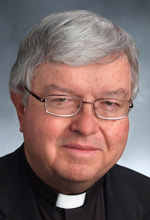Q. We are all familiar with some of the liturgical excesses that came about after Vatican II. When the revised Roman Missal was introduced (in 2011), I seem to remember that the American bishops discussed the need for all U.S. parishes to adhere strictly to the new liturgy.
According to one article that I read, the bishops addressed the practice of inviting members of the congregation to greet those around them before the Mass begins — their feeling being that this detracted from the sign of peace, which the liturgy places just before Communion. Sadly, though, this action continues in many parishes. What is your take on it? (Walnut Creek, Calif.)
A. I am not familiar with the article you reference, nor am I aware of any position taken by the bishops that would discourage parishioners from greeting one another before Mass begins. On the contrary, the closest reference I could find (from the Introduction to the Order of Mass, a pastoral resource issued in 2003 by the U.S. bishops’ Committee on the Liturgy) speaks favorably of Mass attendees being “made welcome by representatives of the community and acknowledged informally by their neighbors.”
Such a greeting is discretionary, of course, and not a stipulated part of the ritual. I have seen it used particularly in vacation areas, to create a sense of community when those at Mass come from various distances and directions. In a normal parish setting, informal greeting and “catching up” is often done in the gathering areas of the church as people are arriving.
Such a practice should never replace the sign of peace, which has a different meaning. Its purpose is not to extend a greeting of welcome, even less to chat with friends, but to offer an expression of charity as a reminder just prior to Communion of the love of Christ that unites the eucharistic assembly.
 Q. We have all been told that Jesus and Mary were like us in all things but sin. I take that to mean that they felt all the emotions that humans naturally experience. But I heard a nun say on television that Jesus was not afraid to die. I don’t believe that. I think he was terrified. (Didn’t he sweat drops of blood from the anticipation of what was to take place?) Likewise, the early 18th-century St. Louis de Montfort said in one of his books that Mary suffered no pain in childbirth. Why not? Was she human or not? (Carrolltown, Pa.)
Q. We have all been told that Jesus and Mary were like us in all things but sin. I take that to mean that they felt all the emotions that humans naturally experience. But I heard a nun say on television that Jesus was not afraid to die. I don’t believe that. I think he was terrified. (Didn’t he sweat drops of blood from the anticipation of what was to take place?) Likewise, the early 18th-century St. Louis de Montfort said in one of his books that Mary suffered no pain in childbirth. Why not? Was she human or not? (Carrolltown, Pa.)
A. Your question is particularly insightful in that it raises two questions that have no definitive answers. First, as to whether Jesus was afraid to die. Some would argue that Luke 22:42-44 clinches it in the affirmative. Jesus says during the agony in the garden: “Father, if you are willing, take this cup away from me,” and we are told that “he was in such agony and he prayed so fervently that his sweat became like drops of blood falling to the ground.”
But is stress the same as fear? When he appeared before the Sanhedrin and before Pilate, Jesus seemed remarkably calm — so much so that Mark observes in 15:5 that “Pilate was amazed.” So who can presume to say what was going through Christ’s mind?
As for Mary and the pains of childbirth, our answer must be similarly cautious. In Genesis 3:16, pain during childbirth is proclaimed as one of the consequences of original sin. Since the dogmatic teaching of the church has always held that Mary was free from original sin, the early church fathers concluded that she must have borne Christ without any pain — and the catechism of the 16th-century Council of Trent reached the same conclusion.
Notably, though, the current Catechism of the Catholic Church, while clearly defining the Immaculate Conception and the virgin birth, is silent on the details of that birth — including the question of Mary’s pain. (And don’t we attest to Mary’s emotional suffering in witnessing her son’s Passion when we mark the feast of Our Lady of Sorrows?)
***
Questions may be sent to Father Kenneth Doyle at askfatherdoyle@gmail.com and 40 Hopewell St., Albany, NY 12208.
PREVIOUS: Our heart’s loneliness for God
NEXT: Fasting is a tie that binds us to Syrians and all suffering people




Share this story